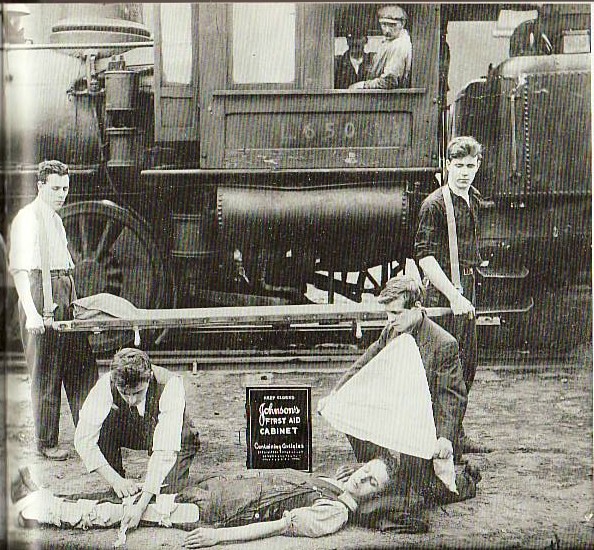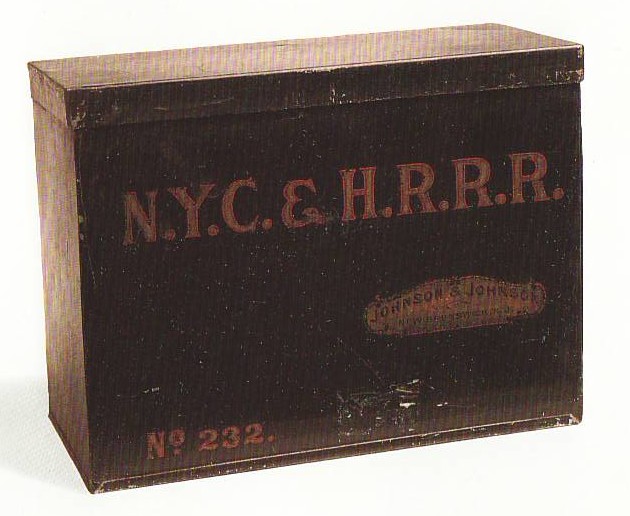First Aid

How did being part owner of a cattle ranch lead one of the founders of Johnson & Johnson to develop the first First Aid kits? During the 19th century, health care was hazardous at best and very little attention was paid to first aid and the proper treatment of wounds and injuries. Robert Wood Johnson the first was part owner of a cattle ranch in Colorado, where he liked to spend vacations. Johnson traveled to the ranch by train and, having an outgoing personality, he started a conversation with the chief surgeon of the Denver & Rio Grande Railway, who complained about the high accident and injury rates among the railroad workers who were laying track to complete the country’s coast-to-coast rail system. Johnson became convinced that Johnson & Johnson could help fill the urgent need for easily accessible medical products to treat railroad injuries. (When injuries occurred, medical supplies were often too far away to be of timely use.) In 1888, he started asking the advice of additional railway surgeons, and in 1890 the Company produced a first aid kit, the “Railway Station and Factory Supply Case,” based on what they had recommended. It was a large wooden case that held antiseptic dressings, surgical supplies, splints and other medical supplies, along with detailed instructions on how to treat injuries. The kits were placed with local railroad station agents along rail routes so they quickly could be sent to the scene of an accident. These early railroad first aid kits were named after the railway lines they were intended to serve, such as the New York City and Hudson River Railroad.

But Robert Wood Johnson didn’t stop there. He enlisted Scientific Director Fred Kilmer to come up with a definition of first aid, as well as the first-ever comprehensive First Aid manuals. This was important because, at the time, there was no standard of emergency “first aid” care, and efforts to help the injured often did more harm than good due to lack of knowledge. Kilmer, who was a thorough and conscientious scientist, extensively researched first aid by communicating first-hand with physicians who treated emergencies and winnowing through the sometimes conflicting information. He published a series of bulletins on first aid, and later compiled the nation’s first-ever comprehensive First Aid Manual. Kilmer defined first aid as a “'bridge between the accident and medical and surgical assistance, over which the patient may be carried safely and securely from the scene of the accident or sudden illness to the doctor or hospital.’” (Robert Wood Johnson, the Gentleman Rebel, by Lawrence G. Foster, p. 62) The Company soon made first aid kits for use in homes, schools, offices, farms and factories, and later, for those new inventions, the automobile and the airplane.

Besides being the inspiration behind Johnson & Johnson First Aid kits, the coast-to-coast railroads also led to the division of the United States into separate time zones, which happened in 1883, three years before Johnson & Johnson was founded.

I didn't know that the time zones came about because of the railroads! You learn something new everyday, I guess!
interesting article, I just found a 1926 johnson and johnson autokit no.8 full of vintage first aid supplies, and maybe the first band-aid in its original un-opened package? dated 1926 :)
fun stuff have a good day !
Hi,
I found your blog on google and read a few of your other posts. I just added you to my Google News Reader. Keep up the good work. Look forward to reading more from you in the future.
Regards,
Jane
I have a tin box that reads- "wood'semergency case" "for first aid" "manufactured by Johnson and Johnson". Can you tell me anything about it?
Hi Michelle,
Woods Emergency Case (No. 6) was a small First Aid kit in a metal box that was designed for multipurpose use. A Johnson & Johnaon First Aid Manual from 1911 describes it as a compact kit that could be used at home, in camp, on a boat or in an automobile. The kits were black metal boxes 7 1/2 x9 x3 inches. They contained wound dressings, gauze, cotton, bandages, ZO Adhesive Plaster (adhesive tape), Camphenol ointment for treating burns and scalds, a tourniquet, scissors, tweezers, safety pins and a J&J First Aid Manual. People would keep the kit for a long time and just refill it with new supplies as needed. Unlike the large First Aid Cabinet No. 1, the Wood's Emergency Case was designed to be portable so that people could take it with them wherever needed. The name came from the middle names of two of our founders: Robert Wood Johnson and James Wood Johnson. Wood was a family name from their mother's side of the family.
Hope that information proves helpful!
Margaret
Hi, i have to take something into my childs school "historical". I have found an old johnson & johnson first aid kit marked 525/4 outfit, first aid for M.T. Australia D ^ D. Im presuming this is 2nd world war first aid kit but can you tell me more about it? thanks so much
Lisa in Australia
Hi Lisa,
Without a photo of the First Aid Kit, it would be hard to give you any information. If you can take a digital photo of the kit and email it to me through the blog, that would be helpful. There's a direct link to the blog's email on the "About the Blog Author" page. Also, Johnson & Johnson has been highly decentralized for many decades, so the Australian First Aid Kit would have been manufactured in Australia.
Thanks,
Margaret
I just found a 525/4 J & J Outfit First Aid Kit which is made in Australia for the defence forces. It has DarrowD inside. It still has some original contents. My uncle was in PNG Kokoda Trail he would have bought it back. I am interested in giving it to a museum.
I have a very old N.Y.N.H.& HRR.Co first aid kit with all of the original bandages and everything but I can not find out anything about it or any pictures of it and it looks nothing like the picture posted above and I was hoping someone could help me find out something about it?
In reply to by Tahlia
Hi Tahlia,
Your N.Y.N.H. & HRR Co first aid kit could potentially be as early as 1890. And with the original contents, you definitely have a piece of history! As you know from reading the post, the first ever First Aid Kits developed by Johnson & Johnson were developed for the railroads. Here's another post with more information on how that happened: http://www.kilmerhouse.com/2011/05/how-a-conversation-led-to-first-aid-kits/
You mentioned that your First Aid Kit doesn't look like the NYC and HRR kit in the post. If you can send me some images of your kit (exterior and contents) through the blog's mailbox, I would be happy to do some research for you and give you more information about your First Aid Kit. Here's the mailbox: [email protected]
Thanks,
Margaret
Hello, I have been looking and looking and looking for information on my first aid kit from 1926 by johnson and johnson (New Brunswick NJ.) everything in the box in sealed and unopened kit includes 2 boxes of bandage gauze, a box sealed of mercurochrome 1/2 fluid ounce, two sealed sticks of ammonia, sissors, 4 sealed waterproof band-aids, box of aseptic sterilized 1/4 ounce, box of sterilized 1/2 yard belleview gauze plain, and a first aid outline all is mint condition, and something called drybak waterproof adhesive suntan color. This is in a tin box. I cannot find anything about this first aid kit and wondered if you knew if this was of value. Thank you so much for any of your help.
Amber Livermore
In reply to by Amber Livermore
Hi Amber,
You've come to the right place! I would be happy to give you more information on your First Aid Kit. Without a photograph, it's difficult to determine which kit you have. If you could email me a picture through the blog, I will research it for you. (Even cell phone pictures would be fine.) The email is: [email protected].
Thanks,
Margaret
We were recently gutting an early 1900's kitchen in a rural PA town and found a Johnson & Johnson printed cloth with figures showing how the cloth can be used to treat wounds on those figures and such. It was in a small, unmarked tin along with a small painted glass jar with a brass fitting that looked like a vaporizer of some sort(?) I will take a photo next time we're there, but can you date the cloth?
In reply to by Ellen
Hi Ellen,
The cloth you found was an Esmarch Triangular Bandage, which was used in first aid. The instructions were printed directly on the bandage. Here's a post with more information: http://www.kilmerhouse.com/2010/10/product-instructions-you-cant-lose/ We began marketing Esmarch Triangular Bandages in the 1890s and made them for many, many decades, so without seeing a picture of your bandage, I wouldn't be able to give you an approximate date. The images from the post I linked to are from 1903, so if your bandage looks more like that, it is probably from that era. The painted glass jar may have been a fumigator, which would have been used to rid a home or building of disease-carrying insects in the days before antibiotics and most vaccines. If you get the opportunity to take pictures, I would be happy to give you more information. You can email them to me at the blog's mailbox: [email protected].
Margaret
Regarding my query above, the home site also was the site of a general store at one time.
Thank you for the information. I'll be sure to photograph the cloth and jar when I visit the house again. I am anxious to share the info with my family!
When was the autokit no. 8 made? And do you have anymore information about it? Thanks, Paige
In reply to by Paige Siedler
Hi Paige,
Johnson & Johnson began making the Autokit No. 8 First Aid Kit in the Nineteen Teens, when automobiles came into widespread popular use. The kit was small to fit into the more limited space in an automobile, and it contained first aid products to treat minor cuts, burns and other injuries. Here's a link to another post with more information about -- and a picture of -- an Autokit No. 8 from the 1920s. In that era, the kits came with a metal badge that attached to the front license plate of a Model A Ford, so that the owners could let people know their cars were first aid kit-equipped: http://www.kilmerhouse.com/2011/09/12-and-a-half-things-you-didnt-know-about-johnson-johnson/
Margaret
HI, I found at a garage sale a Johnson's First Aid Kit No1. It's hard to find any information on it would you be able to tell me some background information. And possibly what its approximate value would be. Thanks!!
In reply to by Tre
Hi Tre,
The JOHNSON’S® First Aid Kit No. 1 was designed to hold a wide variety of first aid products and materials, and could have been used in a factory, a workplace or a home. They were designed to be refilled again and again as the contents were used. Without seeing a photo of your kit, I couldn't give you a date on it. If the metal box is black with red or gold lettering, your JOHNSON’S® First Aid Kit No. 1 is 1920s or earlier. If it's red, white and blue, it would be from the 1930s onward. If you email me a photo of your kit through the blog ([email protected]) I would be happy to take a look at it and give you a more approximate date.
Margaret